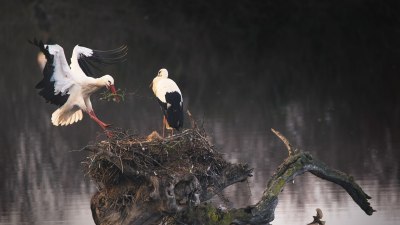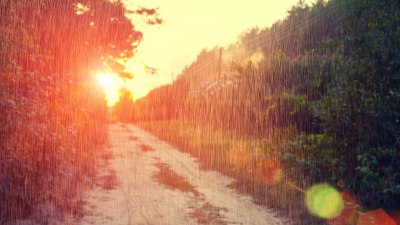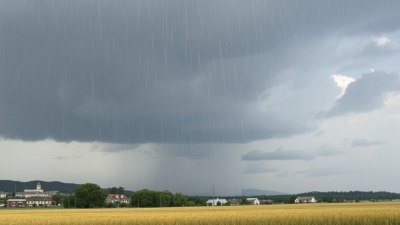Why the Return of Birds is a Sign of Seasonal Shifts
Explore the significance of bird migration and its role in indicating seasonal changes.

The return of birds in spring is one of nature's most beautiful spectacles, signaling the arrival of warmer weather and the renewal of life. This phenomenon, known as bird migration, is a critical part of the ecosystem and serves as an indicator of seasonal shifts. Understanding the reasons behind this return helps us appreciate the intricate relationship between wildlife and their habitats, as well as the broader implications for biodiversity and climate patterns.
Understanding Bird Migration
Bird migration is a natural process where birds travel from their breeding grounds to their winter habitats. Many species of birds undertake this journey every year, traveling thousands of miles in search of food and better living conditions. Migration typically occurs in two main phases: spring migration, when birds return to their breeding areas, and fall migration, when they head back to warmer climates for the winter. The timing of these migrations is closely linked to environmental cues such as temperature, daylight length, and food availability, making them a reliable indicator of seasonal changes.
The Importance of Environmental Cues
Birds rely on a variety of environmental cues to determine when to migrate. One of the most significant factors is the length of daylight, which influences their internal biological clocks. As days lengthen in spring, it triggers hormonal changes in birds, encouraging them to begin their migration northward. Additionally, temperature plays a crucial role; warmer temperatures often mean that food sources such as insects and plant life are becoming available, providing sustenance for the returning birds.
Significance of Bird Return
The return of birds is not merely an aesthetic event; it holds ecological significance as well. Birds play a vital role in pollination, seed dispersal, and pest control, contributing to the overall health of ecosystems. Their arrival can signify the blooming of plants and the awakening of other wildlife, creating a ripple effect throughout the ecological community. Therefore, observing patterns in bird migration can offer valuable insights into the health of the environment.
Species of Birds That Migrate
There are numerous species of birds that migrate, each with its unique migration pattern and destination. Commonly known migratory birds include the American Robin, Barn Swallow, and Canada Goose. The American Robin, for instance, starts its journey back to North America around early March, following a route that extends from Central America to Canada. Similarly, the Barn Swallow travels from wintering grounds in Central and South America to breed in North America, typically arriving in the late spring. Understanding these migration patterns helps ornithologists and conservationists track changes in bird populations and their habitats.
Impact of Climate Change on Migration
Climate change has significantly impacted bird migration patterns in recent years. Changes in temperature and weather conditions can alter the timing of migration, leading to mismatches between birds and their food sources. For example, if birds arrive at their breeding grounds too early due to unseasonably warm temperatures, they may find that insects, which serve as a critical food source for their young, have not yet emerged. This mismatch can adversely affect bird populations and contribute to declines in species that rely heavily on synchronized breeding and food availability.
Urbanization and Its Effects
Urbanization also plays a crucial role in affecting bird migration. Increasingly, migratory routes are disrupted by urban development, which can lead to habitat loss and fragmentation. As cities expand, natural habitats are destroyed or altered, making it more difficult for birds to find suitable nesting sites and food sources. Urban environments also pose challenges such as increased predation from domestic pets, collisions with buildings, and pollution, all of which can deter bird populations from returning during migration.
Citizen Science and Bird Watching
Citizen science initiatives have become an essential tool for monitoring bird migration patterns. Bird watchers and enthusiasts contribute invaluable data by observing and recording the arrival of migratory species in their local areas. Programs like the Christmas Bird Count and eBird allow participants to document bird sightings, helping researchers track changes in distribution and abundance over time. Such community involvement not only fosters a deeper understanding of bird behavior but also encourages conservation efforts for migratory species.
Conservation Efforts
As migratory birds face numerous threats, conservation efforts are imperative to ensure their survival. Organizations such as the National Audubon Society and Birds Canada focus on habitat protection, restoration, and awareness campaigns to address the challenges these birds encounter. Initiatives to create wildlife corridors, protect wetlands, and restore native vegetation are crucial for providing safe migratory pathways and nesting sites. Furthermore, advocating for sustainable practices in agriculture and urban development can mitigate the impact of human activities on migratory birds.
The Role of Indigenous Knowledge
Indigenous communities have long understood the significance of bird migrations and their connection to seasonal changes. Traditional ecological knowledge passed down through generations provides invaluable insights into local bird behaviors and ecological patterns. Indigenous methods of observing nature, including tracking birds and their migrations, contribute to a holistic understanding of ecosystems and inform contemporary conservation practices. Collaborating with Indigenous communities can enhance biodiversity conservation efforts and promote sustainable land management.
Future Directions in Avian Research
As technology advances, researchers continue to explore innovative ways to study and understand bird migration. The use of tracking devices such as GPS and satellite transmitters enables scientists to gather precise data on migratory routes, stopover locations, and the timing of migration. This information is crucial for assessing the health of migratory populations and understanding how they respond to environmental changes. Additionally, genetic studies can shed light on the adaptability of bird species to new conditions, offering insights into their resilience in the face of climate change.
The return of birds is a poignant reminder of the changing seasons, marking the transition from winter to spring. Their migration patterns illuminate the interconnectedness of ecosystems and the impacts of environmental changes. As we observe these avian travelers, it is crucial to reflect on the role we play in preserving their habitats and ensuring their survival. Conservation efforts, citizen science, and collaboration with Indigenous knowledge hold the key to safeguarding the future of migratory birds and the intricate tapestry of life they represent. By fostering a harmonious relationship between people and nature, we can ensure that future generations will continue to witness the magnificent return of birds in spring.











